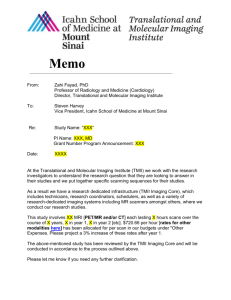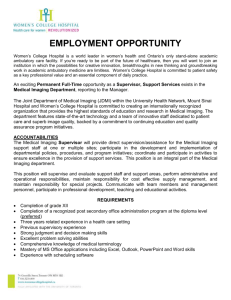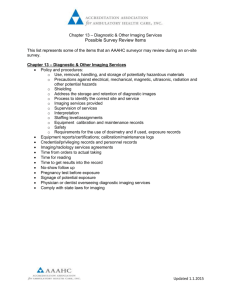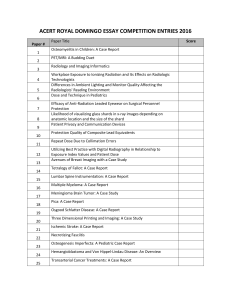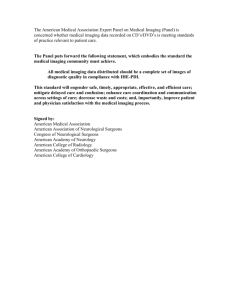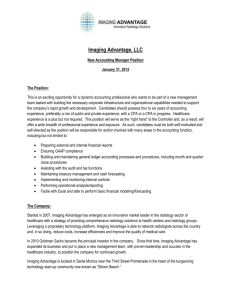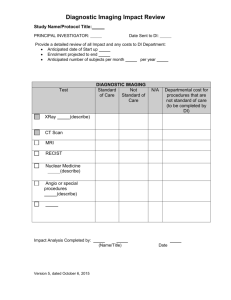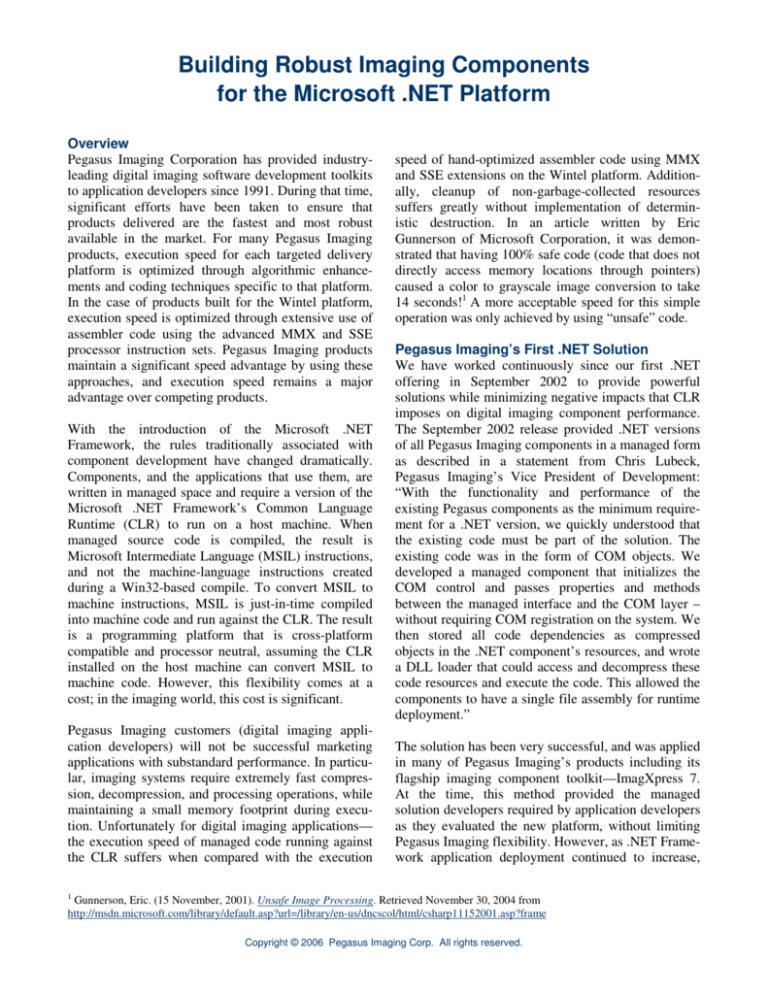
Building Robust Imaging Components
for the Microsoft .NET Platform
Overview
Pegasus Imaging Corporation has provided industryleading digital imaging software development toolkits
to application developers since 1991. During that time,
significant efforts have been taken to ensure that
products delivered are the fastest and most robust
available in the market. For many Pegasus Imaging
products, execution speed for each targeted delivery
platform is optimized through algorithmic enhancements and coding techniques specific to that platform.
In the case of products built for the Wintel platform,
execution speed is optimized through extensive use of
assembler code using the advanced MMX and SSE
processor instruction sets. Pegasus Imaging products
maintain a significant speed advantage by using these
approaches, and execution speed remains a major
advantage over competing products.
With the introduction of the Microsoft .NET
Framework, the rules traditionally associated with
component development have changed dramatically.
Components, and the applications that use them, are
written in managed space and require a version of the
Microsoft .NET Framework’s Common Language
Runtime (CLR) to run on a host machine. When
managed source code is compiled, the result is
Microsoft Intermediate Language (MSIL) instructions,
and not the machine-language instructions created
during a Win32-based compile. To convert MSIL to
machine instructions, MSIL is just-in-time compiled
into machine code and run against the CLR. The result
is a programming platform that is cross-platform
compatible and processor neutral, assuming the CLR
installed on the host machine can convert MSIL to
machine code. However, this flexibility comes at a
cost; in the imaging world, this cost is significant.
Pegasus Imaging customers (digital imaging application developers) will not be successful marketing
applications with substandard performance. In particular, imaging systems require extremely fast compression, decompression, and processing operations, while
maintaining a small memory footprint during execution. Unfortunately for digital imaging applications—
the execution speed of managed code running against
the CLR suffers when compared with the execution
speed of hand-optimized assembler code using MMX
and SSE extensions on the Wintel platform. Additionally, cleanup of non-garbage-collected resources
suffers greatly without implementation of deterministic destruction. In an article written by Eric
Gunnerson of Microsoft Corporation, it was demonstrated that having 100% safe code (code that does not
directly access memory locations through pointers)
caused a color to grayscale image conversion to take
14 seconds!1 A more acceptable speed for this simple
operation was only achieved by using “unsafe” code.
Pegasus Imaging’s First .NET Solution
We have worked continuously since our first .NET
offering in September 2002 to provide powerful
solutions while minimizing negative impacts that CLR
imposes on digital imaging component performance.
The September 2002 release provided .NET versions
of all Pegasus Imaging components in a managed form
as described in a statement from Chris Lubeck,
Pegasus Imaging’s Vice President of Development:
“With the functionality and performance of the
existing Pegasus components as the minimum requirement for a .NET version, we quickly understood that
the existing code must be part of the solution. The
existing code was in the form of COM objects. We
developed a managed component that initializes the
COM control and passes properties and methods
between the managed interface and the COM layer –
without requiring COM registration on the system. We
then stored all code dependencies as compressed
objects in the .NET component’s resources, and wrote
a DLL loader that could access and decompress these
code resources and execute the code. This allowed the
components to have a single file assembly for runtime
deployment.”
The solution has been very successful, and was applied
in many of Pegasus Imaging’s products including its
flagship imaging component toolkit—ImagXpress 7.
At the time, this method provided the managed
solution developers required by application developers
as they evaluated the new platform, without limiting
Pegasus Imaging flexibility. However, as .NET Framework application deployment continued to increase,
1
Gunnerson, Eric. (15 November, 2001). Unsafe Image Processing. Retrieved November 30, 2004 from
http://msdn.microsoft.com/library/default.asp?url=/library/en-us/dncscol/html/csharp11152001.asp?frame
Copyright © 2006 Pegasus Imaging Corp. All rights reserved.
and the evolution of operating environments continued, it became apparent in the fall of 2003 that a more
complete solution was warranted. The limitations of
the September 2002 solution began to dampen the
development experience for some .NET users. Pegasus
Imaging responded in a resounding fashion.
Pegasus Imaging’s Current Solution:
.NET Imaging Without Barriers
Starting in the fall of 2003, Pegasus Imaging engineers
began working to develop a component architecture
that blends the best features of native execution with
managed programming. The result is a way of building
components for the .NET and other component platforms that ensures intuitive programming in all
environments, without sacrificing features specific to
each of them. Imaging technology is built utilizing
native, optimized instructions, while each component
layer calls into this common layer via internal
mechanisms. For .NET developers, each component is
now a single managed assembly, implemented the way
.NET components are intended, with:
• Interface layers built entirely with managed
code using C#
• No wrapping of existing COM objects as had
been done previously
• Object-oriented application programming
interfaces
• Typed exception handling
• .NET compliant event handling
• IDisposable interface support for deterministic
destruction of unmanaged resources such as
bitmaps
• API naming that follows the established
Microsoft .NET Design Guidelines for Class
Library Developers
• Components that verify security permissions
through assembly manifest attributes
• A single file distribution maintained in most
cases
• Context-sensitive help that integrates with all
versions of Microsoft Visual Studio .NET
The first new .NET components were introduced with
the release of PDFXpress™ in November 2004.
During 2005, additional components were made available, starting with ISIS® Xpress,™ and culminating
with the much-anticipated release of ImagXpress™ 8
in Spring 2006. Each component released will be in
the new architectural form, providing the development
experience that .NET developers expect.
Support for .NET Framework 2.0
Microsoft specifies that the recently released .NET
Framework 2.0 will continue to run programs
developed for .NET Framework versions 1.0 and 1.1.
Our testing confirms that our tools continue to work
fully in this new environment. And our commitment to
our customers is to continue to upgrade and improve
our tools to take advantage of the latest technologies
provided by Microsoft as they stabilize and gain
market acceptance.
About Pegasus
Founded in 1991 and headquartered in Tampa, Florida,
Pegasus Imaging Corporation delivers digital imaging
software development components and image compression and editing technologies. The company’s
products exceed speed and quality requirements for
document imaging, forms processing, medical imaging, photo imaging, video applications and more.
Technology is delivered as Microsoft .NET controls,
COM controls, DLLs, and applications. Multiple
platforms are supported, including Windows®, Linux,
Sun® Solaris®, IBM® AIX® and Apple® Macintosh®. For more information about Pegasus
Imaging’s .NET solutions, or for other product-related
inquires, please visit www.pegasusimaging.com, email
sales@jpg.com or call (813) 875-7575.
Finally, all Pegasus Imaging components using our
new architecture are tested for compliance with .NET
standards using the Microsoft FxCop code analysis
tool. Put simply, Pegasus Imaging has developed .NET
versions of our world class imaging components that
closely follow established standards without sacrificing the performance that our customers require.
Copyright © 2006 Pegasus Imaging Corp. All rights reserved.


